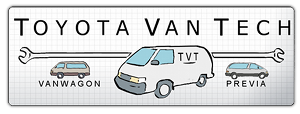-
Van Enthusiast

- Rep Power
- 1
Re: serious shaking at speed: front end? transmission?
Hey jbrush,
I admire your confidence and willingness to explore new worlds  . We all had to R + R our first tranny sometime, right
. We all had to R + R our first tranny sometime, right  .
.
The manual is pretty comprehensive regarding the steps to take in fixing just about any problem with our vans. If you have a grasp, after reading through the process, some time to do the work and the tools and room, I'd say go for it. Keep that 12-pack in the fridge, so you can entice your buddy(s) to hang out and help, as well.
Bearing/bushing replacement generally requires a press, so that may be something that you don't have laying around the garage. You might ask the guy that you've been talking with if they would be willing to help with some of the specialty process(es), if need be.
The drive-shaft (propeller shaft) process seems pretty well laid out, and could be a cause for your trouble. Just to spell out what's going on: the yoke is able to run in and out, to allow the length of the drive-shaft to change as the suspension goes up and down. So those splines need to fit reasonably tight, so there isn't a "banana" effect. The splines being tight keep the drive-shaft straight. The U-joints (spider bearings) allow the transmission to stay in it's fixed position, while the suspension is moving up and down. They also need to be tight, as shown by the tolerance of "0 mm". The U-joints have a "cross" with 4 "shafts". The shafts run on needle bearings inside the caps (which are the visible part inside the "circles" on the drive-shaft. follow the directions for checking that there is no movement, at all, when attempting to turn the yoke, or flange, as directed (PR5 - PRO117). The picture above it (PR5-PRO118) shows a solid drive-shaft, but if you have a drive-shaft with a yoke, you would want to do the measuring with the supports on both sides of the "yoke joint". Remember, the yoke must fit tight to ensure that there is no flex (< 0.8 mm, or <1/32") in the drive-shaft. Make sure you do the "match-marking".
I can't tell you how much fluid might leak out of the tranny, or rear end, but a rag may not completely get it. If I remember, there is about 6 quarts of tranny fluid, so if you have a 2 gallon pail you should be able to stay ahead of an oil spill. The rear end is probably a half gallon or less. Maybe consider changing fluids, if the repair goes well.
Good luck!
Tags for this Thread
 Posting Permissions
Posting Permissions
- You may not post new threads
- You may not post replies
- You may not post attachments
- You may not edit your posts
-
Forum Rules
. We all had to R + R our first tranny sometime, right
.






 Reply With Quote
Reply With Quote
